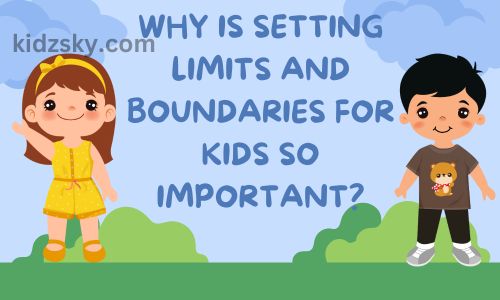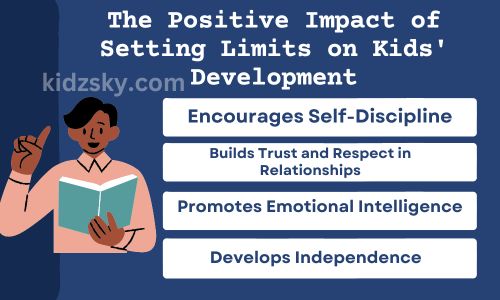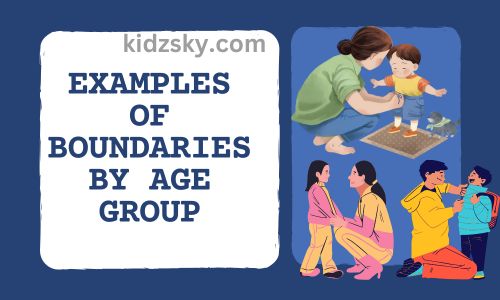Setting limits and boundaries for Kids is a crucial part of parenting that helps children develop respect, discipline, and self-control.
While it may feel challenging to enforce rules, boundaries provide structure and guidance, giving kids a sense of security and helping them understand the world around them.
Healthy boundaries are essential for a child’s emotional, social, and cognitive development.
In this blog, we’ll explore the importance of setting limits and boundaries for kids, implementing them effectively, and how they contribute to raising well-rounded, resilient children.

Why Is Setting Limits and Boundaries for Kids So Important?
Boundaries create a safe and supportive environment for children to growThey serve as a guide, helping kids learn acceptable behaviors and respect for themselves and othersHere’s why setting limits and boundaries for kids is essential:
- Provides Security and Stability: Clear boundaries help children feel safe, knowing what to expect and what is expected of them.
- Fosters Responsibility: Limits teach kids that actions have consequences, which helps them become responsible individuals.
- Builds Self-Control: Boundaries encourage kids to manage impulses and make thoughtful decisions.
- Promotes Respect for Others: Respecting boundaries allows children to value others’ needs and perspectives.
Best Habits:- Teaching Kids the Value of Gratitude: 7 Best Lifelong Gift

How to Set Effective Limits and Boundaries for Kids
Setting boundaries doesn’t mean being overly strict or harshIt’s about setting clear, reasonable expectations and enforcing them consistentlyHere are practical ways to set limits and boundaries for kids effectively:
1Be Clear and Consistent
Consistency is critical to making boundaries workIf rules change frequently, kids might feel confused, leading to frustration or misbehaviorExplain rules clearly so they understand why each rule is in place.
- Example: Instead of saying, “Don’t hit,” explain that “Hitting hurts others, and we use our words to express feelings.”
- Tip: Consistently enforce the same rule every time so your child knows you mean what you say.
2Set Age-Appropriate Limits
Boundaries should be suitable for a child’s age and development levelYounger children may need more straightforward limits, while older children can handle more responsibility.
- For a toddler, set limits like “Hold my hand when crossing the street.” For teenagers, establish curfews and clear expectations for homework.
- Tip: Tailor rules to suit each child’s understanding and maturity and adjust as they grow.
3Use Positive Reinforcement
Positive reinforcement motivates children to follow boundaries willinglyPraise them when they respect limits, helping them see the value in their behavior.
- Example: If they clean up after themselves, acknowledge their effort with praise: “I’m proud of you for putting away your toysThat was responsible.”
- Tip: Reinforce good behavior regularly, and avoid focusing solely on punishment for breaking rules.

4Offer Choices Within Limits
Offering choices within boundaries gives kids a sense of control and reduces resistance to rulesThis helps them feel empowered while respecting set limits.
- Example: If the rule is bedtime at 8 pm, let them choose which book to read before bedThey feel involved, even while following the routine.
- Tip: Use choices to encourage cooperation, helping kids feel that their preferences are respected.
5Explain Consequences Calmly
Instead of punishing, focus on teaching natural and logical consequencesCalmly explain what will happen if a rule is broken and stick to it.
- Example: If they refuse to wear a coat on a cold day, explain they’ll feel chilly without itIf they experience this, they’ll likely choose the coat next time.
- Tip: Avoid punitive responses; let natural consequences guide their learning.
For Parents:- The Benefits of Positive Parenting: Brighter Future of Child

The Positive Impact of Setting Limits on Kids’ Development
Setting and enforcing boundaries plays a significant role in a child’s growthHere are some ways setting limits and boundaries for kids positively impacts their development:
1Encourages Self-Discipline
Boundaries teach kids to regulate themselves and understand that specific actions are off-limitsThis discipline becomes a valuable skill as they grow into adulthood.
2Builds Trust and Respect in Relationships
When parents set consistent rules, kids learn to respect authority and trust guidance, strengthening family bonds and teaching respect for others.
3Promotes Emotional Intelligence
Boundaries help children recognize their emotions, especially when they’re frustrated by a limitUnderstanding these feelings helps develop emotional intelligence.
4Develops Independence
Boundaries give kids freedom within safe limits, allowing them to explore and make decisionsOver time, they become more independent and self-confident.

Examples of Boundaries by Age Group
For Toddlers and Preschoolers
- Simple Language: Keep boundaries easy to understand.
- Examples:
- “Use gentle hands with others.”
- “Hold my hand when walking in public.”
- “Only eat at the table.”
For School-Aged Children
- Concrete Rules and Explanations: Start by giving reasons for the rules.
- Examples:
- “Homework must be finished before screen time.”
- “Ask before leaving the house.”
- “Respect others’ belongings; don’t take without asking.”
For Teenagers
- Mutual Respect and Responsibility: Set limits while allowing for some autonomy.
- Examples:
- “Curfew is at 10 pm; communicate if there are changes.”
- “Chores are to be done weekly.”
- “Always be honest, even if you’ve made a mistake.”
Practical Tips for Setting Limits and Boundaries for Kids
- Be Firm but Flexible: Boundaries should be firm, but you can adapt to specific situations if needed.
- Empathize and Listen: Understand your child’s feelings about limits, showing empathy even when you hold firm.
- Use “I” Statements: Frame boundaries around your expectations rather than making them personalFor example, say, “I expect you to clean up after playing” instead of “You never clean up.”
- Stay Calm and Positive: Keep a calm tone when enforcing rules, as it encourages kids to stay composed.
Kids Activity:- The Benefits of Gardening with Kids: 7 Skills & Fun Together

Common Challenges and Solutions in Setting Boundaries
Challenge 1: Resistance and Testing Limits
Children often test boundaries to see if they’re realThis is a natural part of their development.
- Solution: Stay consistent and remind them of the rules calmlyThis reassures them of the boundary and reduces testing over time.
Challenge 2: Feeling Guilty for Setting Limits
Parents might feel they’re being too strict, especially if the child is unhappy with a rule.
- Solution: Remember that limits show love and careOver time, your child will appreciate the guidance and security boundaries provide.
Challenge 3: Handling Tantrums or Anger
Kids may respond angrily when a boundary is enforced, especially if they feel restricted.
- Solution: Acknowledge their feelings calmly but hold the boundarySay, “I understand you’re upset, but the rule still stands,” teaching them to accept limits without resentment.
Benefits of Boundaries for Parents
Setting limits and boundaries for kids not only benefits the children but also provides advantages for parents:
- Reduces Stress: Clear boundaries help avoid power struggles, reducing daily stress.
- Improves Family Dynamics: Boundaries set mutual respect, leading to smoother interactions and family cohesion.
- Foster’s Confidence in Parenting: Enforcing boundaries consistently helps parents feel more confident and effective.
Best With Family:- Creating a Family Reading Corner: 5 Step-by-Step Best Guide

Final Thoughts on the Importance of Setting Limits and Boundaries for Kids
Setting limits and boundaries might be challenging initially, but the benefits are far-reachingBoundaries foster a child’s emotional growth, teach discipline, and promote self-respect and empathy.
When setting limits and boundaries for kids, remember to keep them age-appropriate and consistent and to reinforce positive behavior.
By providing clear guidance, you give your child the necessary tools to understand themselves better and respect others.
Embrace these boundaries as a powerful part of parenting that helps your child develop into a responsible, confident, and well-rounded individual.
By incorporating these steps, parents can build a nurturing environment that supports growth and creates a foundation for future success.
Admin creates all Photos used in this blog in Canva.




[…] Guide For Kids:- The Importance of Setting Limits and Boundaries for Kids […]
[…] Guide For Kids:- The Importance of Setting Limits and Boundaries for Kids […]
[…] Guide For Kids:- The Importance of Setting Limits and Boundaries for Kids […]